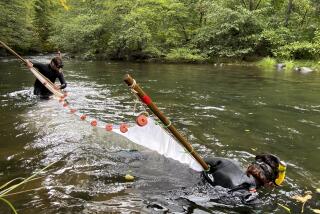Decline of Salmon Inhibits Its Recycler Role
GRANTS PASS, Ore. — A growing body of evidence is showing that salmon are more than just a majestic sport fish, an economic resource or a cultural icon.
From Alaska to California, they serve as a huge natural recycler, responsible for transporting organic material they eat in the oceans and store in their bodies before swimming to the headwaters of watersheds, leaving their carcasses to feed insects, bears, plants, trees and particularly baby salmon.
A recent study published in the journal Fisheries estimates that as little as 5% of the historical biomass of salmon is returning to its native watersheds, creating a dramatic shortage of nutrients derived from the ocean.
The recycling role is so important that restoration of wild salmon in the Pacific Northwest “is hinging on recognition of this issue,” said Jeff Cederholm, a fisheries scientist with the Washington Department of Natural Resources.
Historically, salmon management has been based on allowing just enough fish to return to their native streams, where they die after spawning a new generation.
“We have essentially starved our freshwater systems,” said Bob Bilby, a scientist with the National Marine Fisheries Service in Seattle.
Based on historical cannery records and published accounts, researchers estimated the annual biomass of salmon returning to rivers before the arrival of settlers in Washington, Oregon, Idaho and California.
They found that salmon runs totaling between 352 million and 497 million pounds had declined to between 26 million and 30 million pounds.
“This means that just 5% to 7% of the marine-derived nitrogen and marine-derived phosphorus once delivered annually to the rivers of the Pacific Northwest is currently reaching those streams,” the researchers say in their study. “This nutrient deficit may be one indication of ecosystem failure.”
Jim Lichatowich, an independent fish biologist; Ted Gresh, a graduate student in planning and public policy at the University of Oregon; and Peter Schoonmaker, executive director of the Institute of the Northwest, published their findings in the January issue of Fisheries, the journal of the American Fisheries Society.
“This is sort of like the erosion of genetic diversity,” Lichatowich said in an interview. “It is something you don’t see, but accumulatively it probably could have a big impact.”
The key to this research has been equipment that can identify individual isotopes of chemicals such as nitrogen, phosphorus and carbon, and track them to their source. Using it, scientists have analyzed leaves, plants, young fish and even grizzly bear bones. All showed high levels of nutrients coming from the ocean.
On Washington’s Olympic Peninsula, Cederholm observed 22 different animals feeding on salmon carcasses.
“We have been finding marine carbon and nitrogen in leaf matter of trees growing along river corridors,” Cederholm said. “The only way for it to get there is through salmon swimming up streams, spawning in rivers.”
The trees in turn drop their leaves, branches and eventually their trunks into the river, where they decompose to feed insects, which in turn are eaten by salmon.
“They are a keystone species,” Cederholm said of salmon. “All the other wildlife or plant communities have . . . some dependency.”
Working on the Snoqualmie River in Washington, Bilby found that as much as 40% of the nitrogen in young coho salmon and 60% of the nitrogen in young steelhead came from marine sources.
When they dumped salmon carcasses on streams running into Willapa Bay, they found higher densities of young fish around the carcasses. The young fish were feeding on the carcasses and eggs laid in the river.
The extra food meant juvenile fish grew bigger before migrating to the ocean. Bigger fish survive better, so more fish come back to the river. And so on.
It appears that salmon evolved this as a survival strategy because the streams in the Northwest were generally low in nutrients. So they brought their own lunch.
“If you don’t have the subsidy provided by salmon, those systems gradually decline,” Bilby said. “You’ll still have aquatic life occurring in those streams, but there won’t be much of it.”
The Oregon Plan for restoring dwindling salmon populations recognized this research, and for the last two years volunteers have been tossing salmon carcasses from five hatcheries along rivers on the northern Oregon Coast, where coho salmon originate. Washington state has a similar program.
Research has indicated that 93 to 155 carcasses per kilometer are needed to provide the maximum ecological benefit on coho streams. While Oregon’s goal for coastal coho streams is 26 fish per kilometer, only two to seven fish per kilometer were found in 1997.






